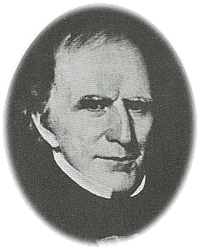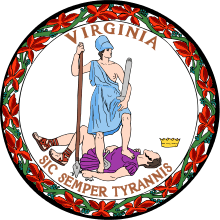William H. Cabell
| William H. Cabell | |
|---|---|
 | |
| 14th Governor of Virginia | |
|
In office December 7, 1805 – December 1, 1808 | |
| Preceded by | John Page |
| Succeeded by | John Tyler, Sr. |
| 6th Chief Justice of Virginia | |
|
In office January 18, 1842 – December 31, 1850 | |
| Preceded by | Henry St. George Tucker, Sr. |
| Succeeded by | John J. Allen |
| Justice of the Virginia Supreme Court | |
|
In office March 21, 1811 – December 31, 1850 | |
| Member of the Virginia House of Delegates | |
| Personal details | |
| Born |
December 16, 1772 Cumberland County, Virginia |
| Died |
January 12, 1853 (aged 80) Richmond, Virginia |
| Political party | Democratic-Republican |
| Spouse(s) | Elizabeth Cabell, Agnes S. B. Cabell |
| Alma mater | College of William and Mary |
| Profession | Lawyer, judge |
William H. Cabell (December 16, 1772 – January 12, 1853) was a Virginia politician and judge aligned with the Democratic-Republican party. He served as Member of the Assembly, as Governor of Virginia, and as judge on what later became the Virginia Supreme Court. Cabell adopted his middle initial, which did not stand for anything, in 1795, to distinguish himself from other William Cabells, including his uncle William Cabell Sr. and first cousin William Cabell Jr.[1][2]
Early life and career
Cabell was born at “Boston Hill” in what is now Cumberland County, Virginia on December 16, 1772. He was the son of Colonel Nicholas Cabell[3] and Hannah Carrington Cabell. Young Cabell studied with private tutors and later attended and graduated from Hampden–Sydney College in 1789[4] and then the College of William and Mary, from which he graduated in July 1793. Young Cabell then moved to Richmond to read law and after completing those studies was admitted to the bar on June 13, 1794.
He began his legal career the following month and soon entered the political arena after adopting his distinguishing initial. William H. Cabell served in the Virginia House of Delegates and as a Presidential elector. He was the 14th Governor of Virginia from 1805 to 1808.
Judicial career
In December 1808, Cabell was elected a judge of the general court. Two years later, legislators selected him for a vacant seat on the Supreme Court of Appeals. He began serving on that court on March 21, 1811, and served continuously for more than four decades. During the court's reorganization in 1831, Cabell was again selected to the new court, where he became president on January 18, 1842. He remained in this position until 1850, but during the last year before his resignation had several absences due to ill health.
Death and legacy
William H. Cabell died on January 12, 1853 in Richmond, Virginia and was interred in Shockoe Hill Cemetery.

Cabell County, West Virginia was named in his honor, as is a residence hall at William & Mary.[5]
Cabell built the Midway Mill in 1787, which later was listed on the National Register of Historic Places, but demolished in 1998.[6][7]
References
- ↑ Brown, The Cabells and their Kin (1895), p. 251
- ↑ "The Cabell Family Papers - Albert and Shirley Small Special Collections Library". Retrieved 1 July 2016.
- ↑ "The Cabell Family Papers - Albert and Shirley Small Special Collections Library". Retrieved 1 July 2016.
- ↑ "Lacy, Drury". The National Cyclopædia of American Biography. II. New York: James T. White & Company. 1921. p. 22.
- ↑ by. "William & Mary - Cabell & Nicholas Halls". Wm.edu. Retrieved 2016-07-02.
- ↑ Virginia Historic Landmark Commission staff (January 1973). "National Register of Historic Places Inventory/Nomination: Midway Mill" (PDF). Virginia Department of Historic Resources.
- ↑ National Park Service (2010-07-09). "National Register Information System". National Register of Historic Places. National Park Service.
External links
- Archival Records
- A Guide to the Governor William H. Cabell Executive Papers, 1805-1808 at The Library of Virginia
- Political Graveyard
| Political offices | ||
|---|---|---|
| Preceded by John Page |
Governor of Virginia 1805–1808 |
Succeeded by John Tyler, Sr. |
